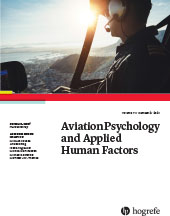Situational Awareness and General Aviation Accidents
An Analysis of 94 US Accident Reports
Abstract
Abstract. Situational awareness is a concept increasingly used in aircraft accident investigation reports. We analyzed 94 general aviation accidents in which situational awareness was mentioned by the National Transportation Safety Board investigator to determine factors that are significantly more often associated with fatality. We found a consistent use of the situational awareness concept, mainly applied to situations in which aircraft inadvertently collided with each other, with other man-made objects, and with various kinds of terrain. A significantly higher proportion of fatal accidents occurred during nighttime, in instrument meteorological conditions, or low visibility conditions. In addition, flights occurring during the cruise phase or in combination with spatial or geographical disorientation proved most often fatal.
References
(2017). Rates and causes of accidents for general aviation aircraft operating in a mountainous and high elevation terrain environment. Accident Analysis and Prevention, 107, 195–201. https://doi.org/10.1016/j.aap.2017.03.017
(1989). Geographical disorientation: Approaching and landing at the wrong airport. Aviation Space Environmental Medicine, 60(10), 996–1004.
(1988).
Spatial disorientation: General aspects . In J. ErnstingP. KingEds., Aviation medicine (pp. 277–296). Butterworth.(2017). Review of general aviation safety (1984–2017). Aerospace Medicine and Human Performance, 88(7), 657–664. https://doi.org/10.3357/amhp.4862.2017
(2019). Occupant injury severity in general aviation accidents involving excessive landing airspeed. Aerospace Medicine Human Performance, 90(4), 355–361. https://doi.org/10.3357/AMHP.5249.2019
(1996). Prediction of situational awareness in F-15 pilots. The International Journal of Aviation Psychology, 6(1), 21–41. https://doi.org/10.1207/s15327108ijap0601_2
(2011). Helicopter accidents at night: Causes and contributing factors. Aviation Psychology and Applied Human Factors, 1(2), 99–102. https://doi.org/10.1027/2192-0923/a00013
(2007). Approaches and landings at wrong airports: Analysis of 54 incidents and 11 accidents, 1981–2004. Aviation Space Environmental Medicine, 78(2), 117–120.
(1995). Toward a theory of situation awareness in dynamic systems. Human Factors Journal, 37(1), 32–64. https://doi.org/10.1518/001872095779049543
(2019). Cross-task cue utilization and situational awareness in simulated air traffic control. Applied Ergonomics, 74(1), 24–30. https://doi.org/10.1016/j.apergo.2018.07.015
(2011). Spatial disorientation: Decades of pilot fatalities. Aviation Space and Environmental Medicine, 82(7), 717–724. https://doi.org/10.3357/asem.3048.2011
(2003). Situational awareness in air traffic management (ATM). Human Factors and Aerospace Safety, 3(3), 237–243.
(2005). Improvements in situational awareness for military fast jet pilots: Organizational and industrial framework. Human Factors and Aerospace Safety, 5(3), 257–265.
(1999). Who is flying the plane anyway? What mishaps tell us about crew member role assignment and air crew situation awareness. Human Factors, 41(1), 1–14. https://doi.org/10.1518/001872099779577237
(1996). Sources of situation awareness errors in aviation. Aviation, Space and Environmental Medicine, 67(6), 507–512.
(2009). Commercial flight crew decision making during low-visibility approach operations using fused synthetic and enhanced vision systems. The International Journal of Aviation Psychology, 19(2), 131–157. https://doi.org/10.1080/10508410902766440
. (2020). Aviation accident database & synopses. https://www.ntsb.gov/_layouts/ntsb.aviation/index.aspx
(2016). Pilot error versus sociotechnical systems failure: A distributed situation awareness analysis of Air France 447. Theoretical Issues in Ergonomics Science, 17(1), 64–79.
(2001). Situational awareness and safety. Journal of Safety Science, 39(3), 189–204.
(2002). Psychological and psychophysiological models of pilot performance for systems development and mission evaluation. The International Journal of Aviation Psychology, 12(2), 95–110. https://doi.org/10.1207/S15327108IJAP1201_8
(2011). Coincidence between the scientific and folk uses of the term “situational awareness” in aviation incident reports. Journal of Cognitive Engineering and Decision Making, 5(4), 378–400. https://doi.org/10.1177/1555343411424694
(2002). Situation awareness and workload in aviation. Current Directions in Psychological Science, 11(4), 128–133. https://doi.org/10.1111/1467-8721.00184
(2008). Situation awareness. Review of Mica Endsley’s articles on situation awareness. Human Factors, 50(3), 397–403. https://doi.org/10.1518/001872008X288420
(2015). Situation awareness: Its applications value and its fuzzy dichotomies. Journal of Cognitive Engineering and Decision Making, 9(1), 90–94. https://doi.org/10.1177/1555343414564571



